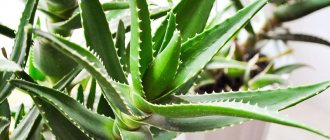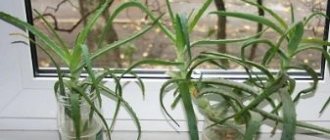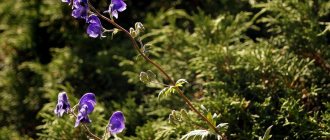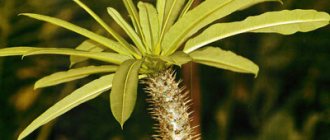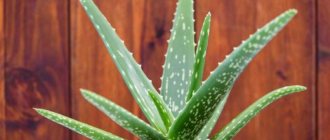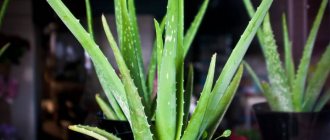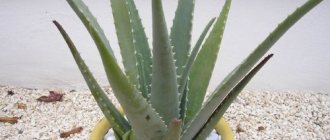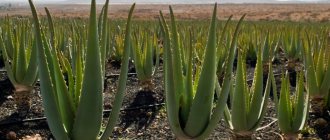Surely since childhood you have been familiar with the domestic representative of the Xanthorrhoeaceae family, and also with the medicinal Aloe. This succulent grows in many homes, its distinctive feature being fleshy leaves framed by thorns, arranged in a spiral in densely collected rosettes.
In the wild, there are about 500 species of plants growing in hot regions - Africa, the Mediterranean and Arabia. These species are very different in appearance; there are real giants - trees reaching a height of up to 20 meters. There are Liana-like Aloe and shrubs with long, about half a meter, spreading leaves. Decorative species of certain varieties grow in our homes. You can find out about the main ones in this article.
Read about caring for homemade aloe
Aloe tree (Aloear borescens) – Agave
At home, with proper care, it can grow up to 1 meter; in nature, there are representatives up to 5 meters in height. It has smooth fleshy leaves, greenish-blue in color, with teeth along the edges. In indoor conditions, the plant almost never blooms, but in nature, during the winter seasons, large reddish flowers with a pleasant aroma appear. Read more about the medicinal properties of agave.
Aloe Tree juice has antibacterial, anti-inflammatory and regenerating properties. If you accidentally cut yourself or burn yourself, you can anoint the wound with the juice of the plant, or apply a piece of pulp.
Asphodelaceae, Asparagusaceae, Monocots
The aloe genus includes more than 500 species of plants. But how to determine its type? They can usually be easily distinguished by visual characteristics such as leaf color and shape, leaf serration, stem height or flowers.
In principle, all types of aloe can be grown as houseplants, with the right location conditions, sufficient space and proper care being crucial. For comfortable living and good vegetation of the succulent, it is best to buy LECHUZA
. A suitable substrate is also a prerequisite for healthy growth. Since all species are succulents, there are small differences in watering and fertilizing.
The variety of aloe species is almost limitless. The spectrum ranges from dwarf forms to tall growing trees, as well as many leaf color variations. We will present you the most beautiful specimens and give you some recommendations for selecting LECHUZA flowerpots for each of them.
Aloe spinous (Aloe aristata)
This species is often confused with Haworthia due to their similar appearance. This plant has thick, arched leaves with a rough surface and white spots. At the end of the leaf there is a characteristic white thread. It usually blooms in late spring with red and orange tubular flowers collected in a raceme (Haworthia has white flowers).
To distinguish Aloe spinosa from Haworthia, you need to pay attention to the fact that Aloe is a solitary plant, and Haworthia has lateral children. Also, Aloe has a less pronounced pattern and convexity on the leaves. An adult Haworthia plant is small in size, in contrast to Aloe Spinata.
Medicinal types
Despite the fact that aloe is an ornamental plant, many people grow it from a practical point of view. Varieties with medicinal qualities include:
- Scarlet soap - stands out with a branched stem with a large number of rosettes. Fleshy leaves with white longitudinal strokes are edged with red thorns. Succulent leaf plates serve as excellent raw materials for creating antiseptics.
- Aloe Barbados or literally “aloe barbadensis” is a succulent with a shortened stem and a rosette consisting of hard bluish leaves reaching 60 cm in length. The almost vertically growing sword-shaped leaf plates along the edges are protected by sharp thorns. Racemose inflorescences on a 90 cm peduncle consist of yellow or red flowers. In literature and in everyday life, its second name is more widespread - aloe Vera.
- Treelike , also known as domestic aloe, is a species often found on window sills, popularly known as agave or aloe agave. A succulent in the form of a shrub or a strongly branching tree, reaching a height of 4 m, has succulent sword-shaped leaves edged with teeth. (Read more about agave here). When blooming, flowers bloom in various shades of yellow or red.
- Aloe intimidating or Aloe ferox is a powerful succulent up to 3 m in height with a single erect central shoot. Depending on the condition of the plant, the intense green color of the leaves, covered with red sharp thorns, may become scarlet under oppressive factors.
Advice! If the owner of one of the medicinal types suffers from a skin disease, then an antiseptic gel with the addition of aloe will help.
For preparation, the succulent itself is used, as well as plantain, chamomile, yarrow and sea buckthorn oil: juice is extracted from the plants, which is thoroughly mixed with oil. The gel is ready for use.
So, if you want to acquire a new, unpretentious plant that can also become a home healer, aloe is the ideal solution. And photos of different types will help you choose the most suitable one, both from a practical and aesthetic point of view.
Aloe humilis
A small herbaceous plant, with dense groups of spines along the edges of the leaves, and a large number of papillae on the outer side. The leaves have a linear-lanceolate structure. Throws out a long peduncle (20-30 cm) with red or orange flowers.
Also read: Unpretentious decorative spurge - Synadenium
Aloe Vera
Like Scarlet Tree, it has medicinal properties. It is distinguished by fleshy leaves with a high water content (97%). The leaves have pale white patches. The composition of this species is very rich in minerals, amino acids, enzymes and beta-carotene. Actively used in cosmetology and medicine. In care, a moderate watering regime should be observed.
Read more about Aloe Vera care and healing properties.
Beneficial features
The juice and pulp of the leaves contain a large amount of vitamins, essential oils, simple acids, as well as flavonoids and phytoncides. The chemical composition of aloe is a real storehouse of useful substances. It is widely used in traditional and folk medicine to treat diseases of the digestive, visual and respiratory systems, as well as the skin. For medical purposes, fresh and evaporated juice (sabur) of adult plants is used, since they contain the highest content of useful substances.
Despite its beneficial properties, aloe can cause enormous harm to the human body, for example, the juice of young leaves and some species causes severe poisoning, and can also lead to kidney problems and miscarriage during pregnancy.
Aloe is a very common plant, loved by gardeners for its unpretentiousness, decorative qualities of leaves, as well as beneficial properties. When choosing a species, you need to take into account the characteristics of the leaf plate and the height of the bush.
Aloe variegata – Tiger Aloe
Variegated aloe is thornless and has dark green smooth leaves with a characteristic tiger pattern. Differs in slow growth. You need to be careful and moderate when watering so that water does not fall on the plant (this can lead to rot and death of the plant). You should also carefully accustom the plant to direct sunlight (it is very sensitive), and it is better to arrange shading if you have a south window. Flowering with red-orange inflorescences.
Contraindications
When used internally or externally, agave and other medicinal types of aloe have no special contraindications. However, in the case of using this plant as a laxative, it should be noted that taking it in high doses can disrupt intestinal motility, causing inflammatory processes in the large intestine.
For this reason, it is strongly recommended not to take drugs based on agave as a laxative for people suffering from uterine or hemorrhoidal bleeding. Another prerequisite for a contraindication to the use of the drug is pregnancy .
We invite you to watch a video about contraindications to the use of aloe:
Aloe erinacea
It has dense dark green leaves with sharp thorns. As they mature, the tips of the leaves and spines darken. The plant is small, bushy. In nature it blooms with tubular flowers of red and yellow colors. There are species with white spines; in some, the spine length can reach 1.5 cm.
Also read: Hoya - wax ivy: signs, care at home
How to replant
It is recommended to replant an adult plant once every 2 years, a young one - once a year. The most favorable time is spring. A drainage layer (5 cm) must be placed on the bottom. For replanting, take a ceramic pot and soil “For cacti and succulents”. You can prepare the soil yourself by taking 4 parts universal soil and 1 part coarse sand.
So, let's imagine that we already have a pot of soil and the plant is ready for planting. Now we perform the transplant in the following sequence:
- Pre-moisten the soil.
- Make a recess.
- Add some sand there.
- Insert plant.
- Sprinkle with sand and soil.
- To provide stability, it is advisable to place pegs.
- Cover the transplanted aloe with a plastic bag, leaving room for air underneath.
- Place the pot on a windowsill where there is more sun.
- When young leaves appear, remove the bag.
At this point, the transplant process can be considered complete. The branches have young leaves - this means that the aloe has taken root.
Aloe Polyphylla - Aloe Spiral
A very beautiful species, with fleshy, triangular, pointed leaves arranged in a spiral. Flowering only in natural habitat - long peduncle up to 60 cm) with pink, rose-red or yellow flowers. The number of leaves per rosette, as a rule, is no more than 30 pieces. Quite a rare species. The spiral can grow clockwise or counterclockwise.
Soil and fertilizing
Add charcoal and brick chips to the soil where aloe will grow.
Or buy a substrate.
Fertilizing with mineral fertilizers is carried out 2-3 times a year and only in summer.
You can use fertilizer intended for cactus plants. It is recommended to apply it to moist soil once every 3-4 weeks. Fertilization should begin in April and continue until the end of September.
Important! Aloe is not suitable for soil that is too nutritious. Do not overuse fertilizing.
Aloe albiflora
The species is small in size with narrow serrated leaves of gray-green color. There are light blotches on the leaves. At home, it blooms in winter (with proper care throughout the year) with white inflorescences that look like elongated bells with green shelves. Growth is slow, not whimsical. Tolerates partial shade well.
Read about caring for homemade aloe.
Other differences
There are other differences between aloe varieties. These are contraindications.
- Agave should not be used for diabetes, problems with blood pressure, or blood vessels. Aloe vera is also not recommended during pregnancy.
- But agave is contraindicated only in oncology (the enzymes included in the composition promote the growth of malignant cells).
Knowing the difference between aloe vera and agave, you can understand what type of crop is needed for home cultivation and further use. But keep in mind that both plants are a real treasure of nature. Among the variety of other plant forms, it is impossible to find a green healer more valuable for health.
